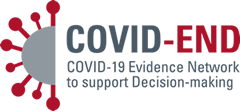Evidence-packaging resources
Principles for evidence packaging
- Recognize the unique evidence needs of four distinct target audiences (patients/citizens, providers, policymakers and managers, and researchers) and relevant intermediaries (e.g., media and guideline developers), and recognize that for now with COVID-19 the two key ones are policymakers and providers
- Before starting a new evidence-packaging initiative, identify existing initiatives that are already reaching a given target audience in a given language and context and consider whether to contribute to an existing initiative or complement existing initiatives in a coordinated way that will make sense to the target audience
- Package only high-quality and timely evidence syntheses, technology assessments and guidelines (with primary attention given to COVID-focused evidence and secondary attention to broader COVID-relevant evidence)
- Package the evidence in ways that can be understood (e.g., plain language and multiple languages) and used easily (e.g., graded-entry formats that provide a bottom-line message followed by more detail for those who want to more) by the target audience and in the context for which it was prepared
- Disseminate the packaged evidence as quickly as possible and ideally through existing channels that are already being used by key target audiences
Approaches to evidence packaging
- Communicating in plain language
- Glossaries of COVID-19 terms like the ones from Dictionary.com, the Kaiser Family Foundation and the University of Aberdeen
- Tools to assess the readability of a communication like the one built into MS Word
- Consistent style for plain-language summaries like this one from Cochrane
- Complementary products like the blogshot, podcast, visual abstract from Cochrane (as well as additional visual abstracts from Emory University’s School of Medicine and infographics from BMJ)
- Dissemination checklist
- Translating content into multiple languages
- Services provided by groups like Translators without Borders and technical second-best options like a Google Translate widget on a webpage
- Organization-wide commitments to translating content into multiple languages by groups like Cochrane and Evidence Aid
- Meeting the needs of groups with distinct information needs
- Patients, consumers and citizens
- Resources to help make sense of health information from Cochrane and from the Cochrane Consumer Network
- Opportunity to collaborate on rapid reviews as part of the COVID-19 consumer rapid-response group or as citizen scientists on the Cochrane Crowd platform
- Additional Cochrane resources to support participation in rapid reviews
- Service providers
- Actionable information to support point-of-care decision-making from Cochrane Clinical Answers
- Living systematic reviews that are updated regularly like the one on drug treatments from Cochrane France
- Policymakers and managers
- Highlighting decision-relevant information like date of last search (to convey the currency of the evidence in a ‘fast-moving-science area’) and the quality of reviews and guidelines being profiled, like in recent rapid evidence profiles from the McMaster Health Forum / RISE
- Approach to drawing out implementation considerations like this one from Cochrane
- Profiles of COVID-relevant evidence from Cochrane’s Effective Practice and Organization of Care review group
- Patients, consumers and citizens
- Grouping content thematically for those with shared interests
- Resources for different clinical specialties like fertility and pregnancy, special collections for public-health and clinical management topics like infection prevention and control, and resources for broader health domains like aging from Cochrane
- Resources for organizations engaged in addressing humanitarian emergencies from Evidence Aid
- Combatting mis-information
- Resources to support fact checking from the Public Media Alliance
- Fact-checking services from Africa Check (Live Guide), Cochrane Ireland (iHealthFacts), and the World Health Organization (Myth busters)
- Providing a ‘daily fix’ about what we know and don’t know
- Daily updates about COVID-19 in general like the one from Johns Hopkins School of Public Health or about COVID-19 evidence in particular like the one from Australia’s Agency for Clinical Innovation.
Search our guide to key
COVID-19 evidence sources
